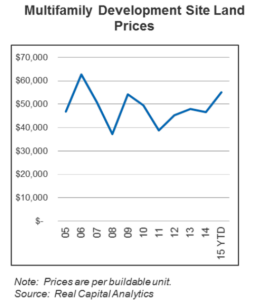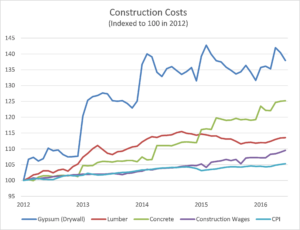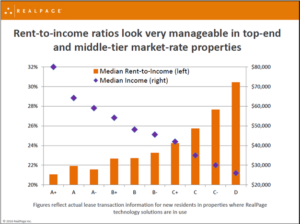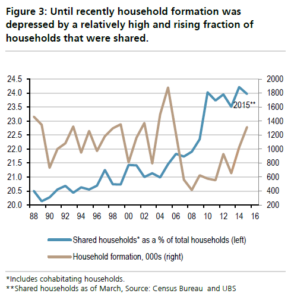There’s No Place Like Apartment Homes | August 2016
August 1, 2016
Year to date as of July 28, 2016, the apartment REIT sector (Bloomberg: BBREAPT) has underperformed the MSCI REIT Index (Bloomberg: RMS G) by over 1,500 basis points (bps). Investors are concerned increasing supply in key REIT markets, principally New York and San Francisco, will have a negative effect on cash flow growth if it is not met by sufficient demand. Though we concede that new supply is above historical averages, we believe, based upon our proprietary housing permit models, that key inputs in the development equation have put the new construction peak within sight and that sector tailwinds are primed to keep the up-cycle alive after the immediate supply is absorbed.
A ‘Peak’ into New Supply
Many factors go into the decision to develop a new apartment building. Key inputs include land prices, construction costs (both labor and materials), rental rates, and financing. After six years of highly profitable development, most, if not all, of these inputs are making new construction difficult to justify.
First, land prices have skyrocketed as the economy has improved, especially since 2011 as seen in Figure 1. Due to strong expected demand, developers have been able to “pay up” for land and still achieve targeted returns due to strong expected demand. However, prices might be reaching a tipping point for apartment developers. Of late, it has not been uncommon to hear apartment REIT CEOs talk about how expensive land has become. For example, Camden Property Trust (NYSE: CPT) recently began construction on Camden Arts District in Los Angeles, California. The company has been working on zoning and entitlement for this site for many years, having tied up the land with an option contract for about $27,000/unit in 2012. Today, management estimates the land would sell for $83,000-$133,000/unit depending on the buyer or end use. At these prices, the required returns would be more difficult to reach, and it is unlikely the project would have been added to the development pipeline at CPT.

Construction on the Rise, but so are Costs
Similar to land prices, construction costs have spiked in the past few years. In some markets, construction costs have increased at double-digit rates annually. Figure 2 shows how some of the most common construction costs have escalated since 2012.

The lack of available skilled labor has contributed significantly to higher construction costs. From 2006 to 2011, the construction industry lost 30% of its labor force. Despite the pickup in construction over the past few years, the industry’s labor force is still 14% below its pre-recession peak in 2006. The lack of labor has given the construction industry the ability to be more selective and negotiate better terms.
A High Rent Problem
In 2015, the median asking rent for newly constructed market rate apartments (or non-rent controlled apartments) was $1,381/month, 70% higher than the median rent for all apartments. This is also despite the decreasing size of the apartment units. Thus, the premium would be even higher on a per square foot basis! The urbanization of major cities in the U.S. is partly to blame, since an inordinate percentage of the high paying job growth has occurred in these locations and a majority of new construction has been focused on dense urban areas.
High land and construction costs, as well as the re-urbanization of major U.S. cities, have forced developers to target the high-end of the apartment spectrum in order validate new construction. This has resulted in a temporary supply imbalance in some cities. However, with construction costs still increasing and future rent growth assumptions healthy, but not as robust as prior years, developers are becoming more disciplined in underwriting new projects and our analysis of permit and construction data confirms a slowing.
‘Regulating’ Supply
As of late, many of the traditional sources for construction financing have become more scarce. New government regulations for commercial banks require the banks to view real estate construction loans as riskier than in the past. As a result, bank underwriting assumptions have become more conservative.
To start, banks are demanding more equity and have even switched from looking at loan to value (LTV) to loan to cost (LTC) ratios, a more conservative metric. The estimated value of a property is calculated based on the cash flow stream after stabilization, and often can be 20% higher than the cost. In the past few years, it was common for merchant builders to achieve construction loans based upon 80% or more of cost. Today, loans at 55-60% of cost are not uncommon. In fact, the management team for Essex Property Trust (NYSE: ESS), an investment grade S&P 500 company, cited a case on their 1Q16 earnings call where the terms of a loan changed from almost 68% LTC down to 60% because of increased bank restrictions.
As a result, developers are forced to become more disciplined when underwriting new projects since raising equity typically involves finding a sophisticated investor who is generally knowledgeable of the risks associated with development. Requiring more equity lowers projected IRR’s (Internal Rate of Return) as equity is more expensive than debt. It also slows down the deal flow as developers have to contribute more capital to fewer projects.
On top of additional equity, banks are also necessitating that developers have more “skin in the game” by requiring more deals to be recourse or partial-recourse. A recourse loan enables the bank to potentially seize a borrower’s other assets in the event of a default. Needless to say, this is a deterrent to developers who are less risk tolerant.
Financing, along with construction costs, land costs, and rental rates play an integral part in the development equation. Right now, all of the inputs are trending against merchant developers. Though current deliveries of apartments are above historical norms, they are reaching an inflection point as developers are forced to be more selective and disciplined. In contrast, apartment REITs have plentiful access to multiple capital sources, and we would expect the REITs to take advantage of the deceleration in new construction and lease-up competition to pursue development with attractive risk-reward profiles.
A Deeper Look at REIT Affordability
Increasing supply has been the leading negative headline for the apartment REIT sector. However, a deeper look would show that the sector is poised to post strong revenue and Net Operating Income (or NOI) growth relative to historical averages.
Affordability is a hot button topic within the apartment sector, especially in expensive markets such as New York and San Francisco. Harvard’s Joint Center for Housing Studies recently reported that 26% of renters paid at least half their income to landlords in 2014, which was up from 20% in 2001. However, most cited affordability stats are in reference to the general public. When digging deeper into the data, rent is not as unaffordable for REIT renters as it may first appear.
The chief economist at RealPage, a property management software maker, suggests that current market-rate renters are actually able to keep up with rising rents and put some money away for savings. RealPage found that the median rent-to-income ratio has hovered between 22.9% and 23.3% since 2010. The tiny move can be attributed to rising incomes for affluent renters who have made a lifestyle decision to stay in the rental pool longer. In fact, the top income segment has been the fastest growing renter group as of late.
The rent-to-income ratios look even more favorable when broken down by the class of apartments. As seen in Figure 3, higher quality apartments attract tenants with higher levels of income. For this segment of income earners, rent takes up a smaller percentage of their overall budget, which should allow for them to more easily absorb rent increases. High quality, Class A and B assets make up most of the REIT portfolios.

Additionally, lease-renewal rates are another way to judge rent affordability. In February 2016, 55.1% of expiring leases were renewed, a 10-year high for the industry according to MPF Research, a division of RealPage. More than 50% of renters have renewed their leases in each of the past 26 months, at an average increase of 4.7%. For comparison, renewal rates were in the mid to high 40%’s before 2010. A higher rate of renewed leases suggests that apartment renters can afford the rent increases.
Higher Wages, Less Roommates
Not only are rising wages allowing landlords to push rents on existing tenants but they are creating additional demand for housing as people can afford to create new households (Figure 4). Under normal circumstances, about 1.2 million net new households should have been formed on average each year from 2007-2013 based on the size and age of the adult population. The actual number averaged only 625,000 per year.

This time period corresponds with the coming of age of the largest age cohort: the millennials (people born between the years of 1981-2000). Millennials are an important group to apartment landlords as their lifestyle choices (getting married/having kids later in life and a preference for mobility) and financial situations make them prime apartment tenants.
Millennials also subscribe to the “sharing economy”, which has made them a source of pent-up demand for apartment landlords. Since 2007, the percent of households that are shared has reaccelerated to reach all-time highs around 24% (Figure 5) as of March 2016. Financial concerns have been one of the top reasons for the lack of household formations among millennials. Between 2000 and 2014, there was an 18% drop in real incomes among 25-34 year olds. In addition, student debt is substantially higher versus graduates 15 years ago.

The good news is the improving economy has finally begun to unlock this source of pent-up demand in household formations. Wage growth has been on an upward trend for the past 6 years, and unemployment is at its lowest level since before the recession, which means wages are likely to continue to increase. As a result of the improving economic outlook for individuals, net new household growth is expected to average 1.3 million per year over the next decade, and millennials should account for over 100% of this growth!
Using data from the National Multifamily Housing Council and the American Community Survey, about 40% of U.S. households are renters and 40% of renters choose to rent apartments. As a base case, using the average propensity to rent apartments, new household formations could generate demand for about 210,000 apartment units per year. This compares to our proprietary estimate of peak supply in late 2016/early 2017 of 400,000 units which is based on new permits and units currently under construction (400,000 is an annualized run rate and the actual 2017 completions should be less). Net of expected demand, this leaves the market approximately 190,000 units over-supplied, which could have about a 100 bps negative impact on the occupancy rate. However, if obsolescence of about 100,000 units per year is included, the impact would only be about -50 bps.
This process is typical for a real estate cycle. Apartment occupancy is currently above the ten year average and last cycle’s peak. This has allowed for above average rent growth over an extended period of time. The wave of new apartment supply will have a slightly negative impact on occupancy and will likely give tenants a little breather on large rent increases. However, occupancy will still be high on a historical basis and, after the excess supply is fully absorbed, moderating new construction and favorable renter demographics will likely swing the market back in the landlord’s favor.
A Long-Term Attractive Sector at a Discount
Over the past three years, the apartment sector has traded at an average 0.5% price/NAV (Net Asset Value) premium to other REIT sectors. Many factors have contributed to the long-term attractiveness of the sector. First, the story is simple. People will always need a place to live, and apartments provide a simple, short-term commitment option in desirable locations. Second, the sector’s short-term lease nature allows rental rates to mark-to-market quickly as the economy improves. Lastly, the sector requires relatively low capital expenditures.
As of July 26, 2016, apartments are trading at a 7.0% discount to other REIT sectors due to negative public sentiment. As long-term investors, we look past temporary distortions that could lower earnings growth for a few quarters. Instead, we view this disconnect with private markets as an opportunity to invest in the innovation centers of our country at an attractive price. The REITs in our portfolio have on average about 40% of their units located in Boston, New York, Seattle, San Francisco, and Los Angeles, and the remainder are mostly located in densely-populated urban markets. We believe job growth in these markets will continue to outpace the rest of the country, and the trend toward renting is here to stay.
Parker Rhea, prhea@chiltonreit.com, (713) 243-3211
Matthew R. Werner, CFA, mwerner@chiltonreit.com, (713) 243-3234
Bruce G. Garrison, CFA, bgarrison@chiltonreit.com, (713) 243-3233
Blane T. Cheatham, bcheatham@chiltonreit.com, (713) 243-3266
RMS: 1904 (1.31.2017) vs. 1904 (12.31.2016) vs. 346 (3.6.2009) and 1330 (2.7.2007)
Previous editions of the Chilton Capital REIT Outlook are available at www.chiltonreit.com/reit-outlook.html.
An investment cannot be made directly in an index. The funds consist of securities which vary significantly from those in the benchmark indexes listed above and performance calculation methods may not be entirely comparable. Accordingly, comparing results shown to those of such indexes may be of limited use.
The information contained herein should be considered to be current only as of the date indicated, and we do not undertake any obligation to update the information contained herein in light of later circumstances or events. This publication may contain forward looking statements and projections that are based on the current beliefs and assumptions of Chilton Capital Management and on information currently available that we believe to be reasonable, however, such statements necessarily involve risks, uncertainties and assumptions, and prospective investors may not put undue reliance on any of these statements. This communication is provided for informational purposes only and does not constitute an offer or a solicitation to buy, hold, or sell an interest in any Chilton investment or any other security.
for more info on our strategy
go now →
for more info on our strategy
go now →
VIEW CHILTON'S LATEST
Media Features
go now →
Contact Us
READ THE LATEST
REIT Outlook
go now →
disclaimers
terms & conditions & FORM ADV
SITE CREDIT
Navigate
HOME
TEAM
REITS 101
Approach
OUTLOOKS
media
Contact
back to top
VISIT CHILTON CAPITAL MANAGEMENT
This property and any marketing on the property are provided by Chilton Capital Management, LLC and their affiliates (together, "Chilton"). Investment advisory services are provided by Chilton, an investment adviser registered with the SEC. Please be aware that registration with the SEC does not in any way constitute an endorsement by the SEC of an investment adviser’s skill or expertise. Further, registration does not imply or guarantee that a registered adviser has achieved a certain level of skill, competency, sophistication, expertise or training in providing advisory services to its advisory clients. Please consider your objectives before investing. A diversified portfolio does not ensure a profit or protect against a loss. Past performance does not guarantee future results. Investment outcomes, simulations, and projections are forward-looking statements and hypothetical in nature. Neither this website nor any of its contents shall constitute an offer, solicitation, or advice to buy or sell securities in any jurisdictions where Chilton is not registered. Any information provided prior to opening an advisory account is on the basis that it will not constitute investment advice and that we are not a fiduciary to any person by reason of providing such information. Any descriptions involving investment process, portfolio construction or characteristics, investment strategies, research methodology or analysis, statistical analysis, goals, risk management are preliminary, provided for illustration purposes only, and are not complete and will not apply in all situations. The content herein may be changed at any time in our discretion . Performance targets or objectives should not be relied upon as an indication of actual or projected future performance. Investment products and investments in securities are: NOT FDIC INSURED • NOT A DEPOSIT OR OTHER OBLIGATION OF,OR GUARANTEED BY A BANK • SUBJECT TO INVESTMENT RISKS, INCLUDING POSSIBLE LOSS OF THE PRINCIPAL AMOUNT INVESTED. Investing in securities involves risks, and there is always the potential of losing money when you invest in securities including possible loss of the principal amount invested. Before investing, consider your investment objectives and our fees and expenses. Our advisory services are designed to assist clients in achieving discrete financial goals. They are not intended to provide tax advice, nor financial planning with respect to every aspect of a client’s financial situation, and do not incorporate specific investments that clients hold elsewhere. Prospective and current clients should consult their own tax and legal advisers and financial planners. For more details, see links below to CRS (Part 3 of Form ADV) for natural person clients; Part 2A and 2B of Form ADV for all clients regarding important disclosures.